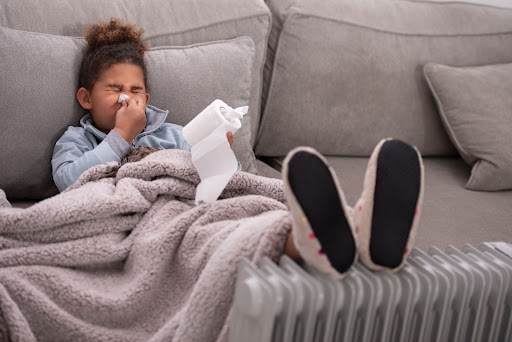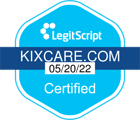Contributions by: Ashton Thornton, RN, BScN
If you have little ones who have started attending daycare or are in their earlier years of school, you already know the impact of the viral season on the home.
Due to the proximity of all the kids playing together at school, it’s very difficult for them to avoid contracting many of the common viral childhood conditions. Roseola, Impetigo, Hand, Foot and Mouth, Fifths Disease and Pink Eye are examples of these.
These common conditions are nothing to worry about!
With knowledge and expert pediatric advice from our specialized KixNurses, you can keep your children safe and healthy while they start their school careers.
Our health and wellness membership, Kix360°, offers 24/7 access to our team of specialized pediatric Registered Nurses who can give our KixFamilies: support and advice about their child’s condition, explain why they need the prescription, and how to take the prescribed medication, as well as providing ongoing management throughout the presenting illness – which the pharmacist may not be able to provide.
Our KixFamilies also have access to our pediatric Nurse Practitioners, who can diagnose, prescribe and make referrals to Pediatricians and Allied Healthcare Professionals as needed.
This allows families to feel supported during their urgent care concerns, but in addition to any urgent care matters, no matter how big or small the concern or question is, Kix360° is here to support all of your child(ren)’s health and wellness goals.
Roseola
Roseola is a viral illness most commonly occurs in children between 6 months and 2 years of age. It is very contagious and can be spread through contact as well as through the air.
Symptoms of Roseola can include:
- A high fever which lasts up to 5 days.
- Your child may be visibly upset, grumpy, and irritable.
- After the fever has subsided, your child will get a rash of small pinkish-red spots on their face and body. The rash can last anywhere from a couple of hours to 2 days; it’s not usually itchy.
Despite the rash and fever, Roseola is not severe and tends to go away on its own.
However, if your child has Roseola, you can help by:
- Treat the fever with Tylenol and/or Advil
- Offer your child plenty of fluids
- Rest
- Talk to a KixNurse
Seek further medical assistance if your child:
- Has a fever for more than 5 days.
- Is under 3 months old and has a fever.
- Is lethargic
- Not drinking and concerned about dehydration.
If your little one experiences these symptoms, contact one of our KixNurses immediately. We will be able to assess your child’s symptoms, provide over-the-counter medication recommendations, and, if necessary, direct you to one of our Nurse Practitioners who can diagnose, prescribe, and refer you to our team of Pediatricians and Allied Healthcare Professionals.
Impetigo
Unlike most of the other items on this list that are viral, Impetigo is a bacterial infection that usually affects school-aged children with other skin problems like eczema, poison ivy, or irritated skin.
Impetigo usually appears around the mouth, nose or on skin that isn’t covered by clothes. The rash can start as a cluster of red bumps or blisters. Eventually, the blisters may ooze or be covered with a honey-coloured crust.
Seek further medical attention if your child has a fever, pain, swelling, or heat/redness around the rash.
Treatment for impetigo is an antibiotic cream that you apply topically (rub into the skin) or take by mouth.
If you think your child might have impetigo, talk to one of our KixNurses. They can confirm if the rash is impetigo, recommend antibiotics, and create a customized care plan for you to follow so your little one can fully recover and be back in school as soon as possible!
Hand, foot, and mouth disease (HFM)
Hand, foot and mouth disease is a common viral infection that causes a rash made of painful red blisters. While uncomfortable, this is not normally severe, and children fully recover in 7-10 days.
If your child has HFM, you may see:
- Fever and malaise that is usually just for a few days, followed by:
- Small, painful ulcers in the mouth and back of the throat (not always).
- A skin rash that looks like red spots, often with small blisters on top.
- They usually appear on the hands (palms) and feet (soles), buttocks and sometimes other places on the body.
- sore throat – this may cause children to refuse to drink and puts them at risk for dehydration.
- Vomiting and/or diarrhea.
Hand, foot and mouth disease can affect any age but is most common under age 7.
Practicing good handwashing is your best defence.
Rashes can be tricky! With HFM, the rash can be “textbook” but also sometimes appear on other areas of the body and not their hands and feet at all! If you think your child might have hand, foot and mouth disease, talk to one of our KixNurses. They can confirm if the rash is HFM, recommend treatment, and create a customized care plan for you to follow so your little one can fully recover and be back in school as soon as possible!
Antibiotics will not help. This is a viral illness, and we focus on supportive care, including Acetaminophen and Ibuprofen for your child’s fever and any discomfort they may be experiencing.
Seek medical assistance for your child if:
- Is vomiting and showing any sign of dehydration, such as:
- no tears when crying.
- dry skin, mouth and tongue.
- less or no urine
- refusing food and/or fluids because of mouth sores.
- Is breathing rapidly.
- Has a severe headache, especially with vomiting, confusion or unusual sleepiness.
Fifths Disease
This is a very common childhood virus. Sometimes called “slapped cheek” syndrome. This is because the red rash it causes on their cheeks looks like someone has slapped them! This is usually very mild.
Your child with Fifths disease:
- In most cases, for the first 1-4 days, children will show general viral cold-like symptoms such as fever, congestion and runny nose.
- Then the rash will develop, starting with very red cheeks.
- It will then spread over the body looking like a “lace-like” rash. Starting on the trunk and then going to the arms and the rest of the body.
- This rash is painless and can last up to 3 weeks.
- Once the rash appears, your child is no longer contagious.
Antibiotics are not used to treat Fifths disease. This is a viral illness, and we focus on supportive care, including Acetaminophen and Ibuprofen for your child’s fever and any discomfort they may be experiencing.
If you think your child might have Fifths disease, please reach out to one of our KixNurses. They can confirm if the rash is worrisome, recommend treatment, and create a customized care plan for you to follow so your little one can fully recover and be back in school as soon as possible!
Pink Eye
Pink eye (conjunctivitis) is inflammation affecting the eyeball’s covering, and the eyelid’s inside. This can be either a viral or bacterial infection.
If your child has pink eye, they may:
- Complain of a scratchy feeling in their eye(s).
- Experience frequent tearing.
- Have pink or red eye(s) instead of white. The eyelid may also be slightly swollen.
- Have pus or discharge from the eye(s), making the eyelids sticky during sleep. This pus or discharge may be yellow or even green.
KixTip! It is common for a child with pinkeye to wake up from sleep with their eyes crusted shut from the pus. This can be scary for the child and you. If this happens, don’t panic. Apply a warm wet washcloth to the eye and then gently wipe the crust away. Saltwater (saline) also does a good job of helping to break up stubborn crustiness.
Wash your hands! This is very infectious, and it is important that you wash your hands before touching your eyes, as well as wipe down high-touch surfaces with
Most cases of pinkeye are caused by a virus, so antibiotics will not help. If this is the case, you can treat symptoms with saline drops and warm compresses. It should go away on its own.
However, in some cases, your child might need to take antibiotics. If the discharge from your child’s eye is very yellow, copious or green. They may need antibiotics.
Talk to a medical professional if:
- Your baby has purulent eye discharge and is less than 3 months old.
- If you think your child has pinkeye. It is not easy to know if a bacteria or a virus has caused the infection.
- If your child seems unwell and has a fever, rash, swelling or eye pain, or if the pinkeye keeps coming back. Some more serious illnesses may look like pink eye at first.
Knowing whether your child’s pinkeye requires antibiotics is sometimes difficult. Talk to a KixNurse today to assess the severity of your child’s pink eye and guide you through the following steps to nursing your child back to health.
Our KixNurses can assess your child’s symptoms, identify the healthcare concern, and navigate you to the fastest and most efficient care route. Whether it’s your local pharmacist or a referral to one of our Nurse Practitioners, your child will quickly get the medication and care they need.
Our KixNurses will continue to check in with your child about how they are feeling and keep an eye on these common healthcare concerns to see if they are healing as they should.
What is included in my Kix360° membership?
- 24/7 access to pediatric Registered Nurses
- Appointments with Nurse Practitioners
- Unlimited visits per family
- Video calling and Messaging through a dedicated app
- Expert pediatric health and parenting resources
- Webinars from pediatric professionals
- Accessible, worry-free, professional pediatric healthcare

Visit our Employer Page to learn more about adding Kix360° to your company’s Employee Benefits Plan.



![Verify Approval for [YOUR-WEBSITE-URL].com](https://static.legitscript.com/seals/11167439.png)
